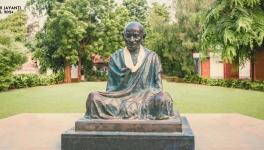Wildlife Experts Defend Gujarat Forest Officer after State Issues Notice
Shyamal Tikadar, Gujarat’s Principal Chief Conservator of Forest and Chief Wildlife Warden, was recently issued a notice by the state government after some remarks he made at a webinar were reported by the media.
On the eve of World Lion Day on August 10, a webinar was held by the Central Zoo Authority and Tikadar was on the panel. He said with nearly 80% of the lions in the state now micro-chipped, they were “not wild”. He also commented on the rising number of the big cats and the increasing possibility of conflict with human populations.
H.S. Pabla, the former chief wildlife warden of Madhya Pradesh, wrote to the Chief Secretary of Gujarat and officials of the Ministry of Environment, Forest and Climate Change in defence of Tikadar. He wrote: “As a former Chief Wildlife Warden of Madhya Pradesh, I am deeply pained to see this development. Firstly, senior public servants should not be so shackled that they are afraid of giving sane advice to the government. Secondly, the views expressed by the PCCF are most appropriate under the current circumstances as the way Asiatic lions are being managed in Gujarat is not sustainable. This is neither good for the lions nor for the people of Gujarat. The best way to preserve the pride of Gujarat is to find ways of making them a source of livelihood for rural communities through sustainable ecotourism and ensure that they stay within the forests. I think Mr. Tikadar's comments were spot on and the state must tread the path recommended by him. In any case the state will come out in very poor light if any action is taken against a senior functionary of the state just for sharing his honest views in an academic discussion.”
In Jaipur, wildlife enthusiast Harsh Vardhan too says the government must be more open to bureaucrats in the forest department expressing their opinions, for that would be one way to arrive at a solution to the problems posed by the success of conservation efforts. Lions and tigers, like all other cats, breed well when left alone and when their numbers rise, they disperse beyond protected areas as a way to avoid conflict with dominant males. This has happened even with the tiger population in Ranthambore, Rajasthan.
Meanwhile, it was reported in July that the state government abruptly – without offering any explanation – withdrew permission for a study that was being undertaken by the Wildlife Institute of India, to understand lion corridors in the area and human-animal interaction. As part of the study, 20 lions had been radio-collared between 2005 and 2014.
A lion census, which takes place every five years, was supposed to happen in May. It was put off on account of the COVID-19 crisis. In June, the Gujarat government announced that there were 674 lions in the state. The census was not conducted in the usual manner – in what is called “poonam avlokan”, a counting exercise held each month by forest staff at the time of the full moon, was accepted as the census count. The counting procedure covered 10 districts of the state where lion movement was reported. Generally, NGO functionaries and volunteers are also called in to assist forest staff in census operations. Since one case of a novel coronavirus infection in New York was reported to have originated from a tigress, forest officials did not want to risk having a lot of people undertaking the census exercise this year.
The last census was in 2015 and 523 lions were counted, a number which was up from 411 in 2010. What this indicates is a steady rise in the number of lions, even when the protected area for these big cats is not increasing. In May, Mongabay reported that nearly half the lions in India now live outside protected areas, and the population of lions roaming outside such areas is growing at a fast rate. Human population too is rising in these areas, and conflicts are thus to be expected.
The state forest official, speaking at the webinar, indicated that there was a need to plan for this and see how conservation could be made attractive to local people. Eco-tourism should be designed such that the people could earn an income too, he had said. A lion needs a daily diet of about 10 kgs of meat, and the prey base has to be sufficient. Conservation efforts for a species like the lion have to take the entire ecology into consideration, wildlife activists and experts say.
The lions in Gir, Junagadh, Somnath, Bhavnagar and other parts of Gujarat, have learned to navigate living close to human habitations, and will sometimes prey on livestock and emerge close to human settlements by night. In some areas, human populations too have grown accustomed to the ways of the wild cat. This close interaction with domestic animals, however, also leaves them especially prone to diseases peculiar to domestic animals. In 2018, several wild lions were killed by an outbreak of canine distemper.
Translocation of the lion was one plan that was considered, given the rising number of lions in the area and the possibility of conflict with settled human populations. Kuno Wildlife Sanctuary in Madhya Pradesh was supposed to be the site to which lions could be moved; on April 15, 2013, Supreme Court passed an order seeking that the translocation be completed in six months. More than six years later, there is no progress – the government of Gujarat was unwilling to part with its lions.
Even within the Gir National Park though, there is only about 250 sq. kms of wilderness. People and livestock share the space in the remaining 1,200 sq. kms of the park. Such sharing comes with mutual benefits that are not completely understood. A zoo in Germany has been selling the bottled excrement of lions, since it was found to keep other animals away.
Instead of punishing him, the Gujarat government should pay heed to Tikadar and take necessary measures to protect this magnificent species while also conserving nature and finding ways for forest dwellers to emerge as champions of conservation.
The writer is a freelance journalist.
Get the latest reports & analysis with people's perspective on Protests, movements & deep analytical videos, discussions of the current affairs in your Telegram app. Subscribe to NewsClick's Telegram channel & get Real-Time updates on stories, as they get published on our website.
























